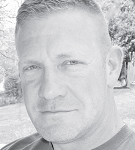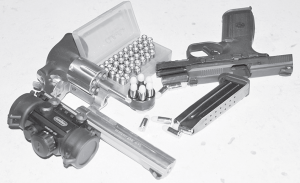by Chris Cerino

Chris Cerino is a nationally known firearms instructor who has been training law enforcement officers and military for more than 10 years. He will now be writing a monthly “Training Tips” column for The Gun Mag.com. He has worked in law enforcement positions for municipal, county, state and federal agencies spanning 19 years.
We have been running clinics, four hour training sessions, at the local firing range the last few months. Some of our students are competitive shooters who belong to the range and shoot the bowling pin matches weekly, some are CCW permit holders looking for training beyond the standard CCW curriculum.
No matter what their intentions are they all seem to need the same thing from the training: weapon handling and manipulation skills: gear manipulation skills, and greater understanding of the fundamentals of marksmanship. The common theme seems to be that they are unfamiliar with anything but the most simple ways of loading their gun, taking it from a holster (if they use one), sight alignment, sight picture, trigger press and then shooting the gun, usually until it is empty so they never have to formally unload it. Whether you intend to use a gun for self-defense or competition you need to be able to do all of these things in some combat or tactical fashion. It all starts with getting your mind right.
Knowing that the competition or your life depends on how you prepare right now.
Your range sessions need to consist of more than taking your gun from its case, laying it on the shooting bench, filling magazines (or loading the cylinder) and then shooting it in some contrived shooting stance slowly in a bull’s-eye fashion. Unless, of course, you are practicing for a bull’s-eye match! I am also well aware of the ranges that do not allow drawing from a holster.
Here are some things to think about for the next time you go to the range to “shoot,” so it can be more like training.
Get a good holster, maybe a magazine pouch and some dummy/inert training rounds for the caliber pistol you have. With these three items you can begin to train yourself safely and solidly. Now you can do some dry practice. Dry practice, not just dry fire, has a lot of value and won’t cost you anything more than time. Of course, there are safety precautions you need to be aware of before you begin.
— Always adhere to the 4 firearms safety rules when handling any firearms.
— Be sure your firearm and magazines are cleared of any live ammunition. Check it twice both visually and physically!
— Select a special location in your home to dry fire where there are no loaded firearms or live ammunition.
— Select a safe direction in that area to dry fire. Maybe an exterior wall.
— Always announce a formal start to your dry fire practice.
— Always announce a formal end to your dry fire practice.
When performing dry practice I work on the foundations of my shooting skills; loading: unloading and clearing; drawing from the holster or presenting to a target from a ready position, and add some dry fire using a two hand grip, one hand strong hand and/or one hand weak hand. You are now doing everything without having muzzle blast, recoil and holes in the target to stare at. My instructors and I feel very strongly about the validity of dry practice. It is a part of every class we teach.
Without being able to go into the details of all these skills, I can however give you some food for thought until next month.
Practice loading your gun using dummy rounds. Become familiar with the controls of your gun, the slide lock lever, magazine release and any external safeties and the force it takes to manipulate them. Search videos on the Internet of these skills. You will see the big names in shooting and get to watch how they handle their guns and gear. You will get some great pointers and probably even find some quality instructional videos. Practice unloading and clearing your gun by removing the source of ammunition, locking the slide to the rear and visually and physically inspecting the chamber and magazine well.
Practice drawing from a holster or with the gun out, presenting the gun to a target. Videos on the combat draw stroke are out there. Dry fire! If your gun has a double-action and single action trigger pull practice them both dry. Get a feel for what it takes to pull the trigger in double-action and then in single-action. Find the reset on the trigger by pressing the trigger, holding it to the rear, cycling the slide and then letting the trigger forward to find the telltale “click” of the reset. Work those same trigger presses pointing your gun at a blank wall watching for movement in the sights. Adjust your trigger finger placement or grip until you stop those unwanted movements. Learn your gun and become intimate with its functions.
Work with your holster and magazine pouches. Don’t neglect the re-holster.
Stay in control and alert when re-holstering.
Practice loading magazines from magazine pouches or pockets. Put ’em in and drop ’em out until it becomes a fluid motion.
Over the years it seems, the biggest problems on the range with civilians, police or military is that folks simply don’t handle their guns enough to build familiarity. Take some time to learn your guns and your gear. It’ll show next time you go to the range. You’ll be more comfortable and competent.
Over the next few months I’d like to go into the details of all of these skills so that you can build a dry practice plan to improve your live range skills.
Until next time remember, Those who can, Do. Those who understand, Teach.
Visit: chriscerinotraininggroup.com



